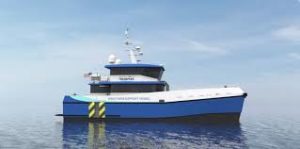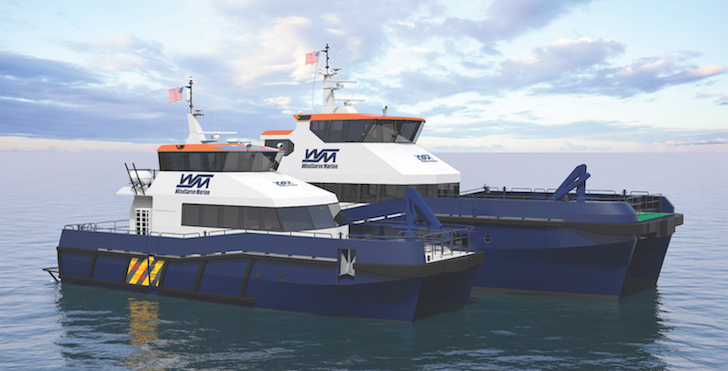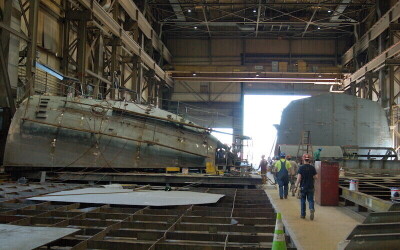Work is underway on the next support vessels for the fledging U.S. offshore wind energy industry, even as federal regulatory review — and now the global economic upheaval of coronavirus – clouds the prospect of building ambitious power projects.
The 804-megawatt Vineyard Wind project in southern New England waters, leading the pack of more than a dozen proposed wind energy arrays off the East Coast, remains stalled as the federal Bureau of Ocean Energy Management reassesses the cumulative environmental impacts.

Blount Boats is building two 65' CTVs for Atlantic Wind Transfers developed by the UK's Chartwell Marine. Blount Boats rendering
The agency’s final impact statement is scheduled for December 2020. In the meantime, Atlantic Wind Transfers LLC, North Kingston, R.I., the first U.S. provider of offshore services to a wind farm, is pushing forward with its builders at Blount Boats, Warren, R.I., to construct two more crew transfer vessels (CTVs).
Atlantic Wind Transfers president Charles Donadio — a 22-year veteran of the offshore ferry business who had Blount build the first U.S.-flag CTV — aims to be ready first when BOEM allows wind developers to proceed.
“There’s a lot of people looking to jump into the industry. Nobody in the United States has experience but us,” said Donadio, whose 70’6”x24’x4’, $4 million catamaran CTV Atlantic Pioneer began serving the Block Island Wind Farm in 2016.
Donadio said lessons learned on the job with Block Island developer Deepwater Wind (since acquired by Ørsted) are being applied to the coming additions to his fleet — specialized models of the Chartwell 24, with the first now under construction at Blount and expected for delivery in October.
Developed for the European wind industry, the Chartwell design is modified to meet U.S. environmental regulations and operational conditions in Northeast waters. That includes a 65’ hull length to comply with federally mandated speed regulations during migration periods of the endangered northern right whale.
When construction begins on wind projects, each site is going to come with its own set of restrictions protecting whales and other species, said Donadio. “The right whale is going to be a factor every wind farm will need to deal with.”
In training its mariners, Atlantic Wind Transfers had the fortune to work its new vessels around steel turbine foundations off Block Island for two months before tower construction began.
“We already had foundations in place. To have training at the site, day in and day out, is priceless,” said Donadio. “It’s not as easy as you think. It’s not like driving a tugboat or a ferry.”
That was after a six-week fulltime training program for crew, with help from industry professionals in the United Kingdom.
NEW CTVs
The Chartwell design being built at Blount features a hull configuration that minimizes wet deck slamming – a vice of some catamarans when they take wave impact between their hulls – and a large foredeck that eliminates a step-up for technicians when they disembark onto the turbine base.
Right behind them is WindServe Marine LLC, a subsidiary of New York City-based Reinauer Group. The company is now building its first of two CTVs at Senesco Marine, close to Atlantic Wind Transfer’s terminal in North Kingston, R.I.
Those vessels will first serve Ørsted’s Coastal Virginia Offshore Wind Project, a pilot project with Dominion Energy for two 6-megawatt turbines that has a historic first as the first wind project approved for federal waters (the Block Island Wind Farm was built in Rhode Island state waters). They will then go on to deployment to other planned Ørsted projects.
Designed by BMT, the WindServe CTVs will be a package that serves operational requirements and the right whale challenge.
“It’s something we’ve not come across yet in Europe as we don’t have this right whale issue,” said James Lewis, BMT project manager for specialized ship design, who led the team behind the first CTVs for Ørsted’s offshore wind developments in U.S. waters.
The need for more crew and cargo capacity, speed and comfort on CTVs “grows and grows along with the industry, from 16, 17 meters … our wind farm vessels now are up to 26 and 27 meters,” Lewis said when the design was unveiled in June 2019. The designers were looking at a similar size for the U.S. market that would have been around 85’. “Then it comes out down the line about these seasonal closed areas for right whales,” said Lewis.
So BMT designers reverted to an earlier 20-meter hull form that could be tweaked to stay within the 65’ seasonal 10 knots speed limit threshold, “and still have the power we need,” he said.
The catamarans will carry 20 passengers plus four crew, at top speed around 28 knots, with power from four Scania engines of around 800 hp each. The designers are using Tier 3 power because compressing speed and functionality into the 20-meter hull form leaves little room for the bulk of a Tier 4 exhaust treatment system, said Lewis.
“The emphasis has always been on speed, comfort, get them out there,” said Lewis. With this design “if it’s 50 miles offshore you can get there in two hours.”
Having two engines in each hull gives “redundancy and a huge amount of power,” he said. “It can get you home safely if it loses two or even three engines.”
From their bases on Narragansett Bay, Atlantic Wind Transfers and WindServe Marine would be poised to provide their new boats as the first generation of CTVs for utility-scale offshore projects.
“After that, it’s hard to say what will happen because everything is delayed because of the Vineyard Wind project” and its protracted regulatory review, said Luther Blount III, director of engineering at Blount Boats. “It’s on hold for a bit so there’s not a lot of people who will do boats on spec.”
If Vineyard Wind gets its environmental impact statement and permits to build, it would be the first in more than a dozen projects lined up for federal leases off the East Coast. That could create a lot of demand in the early 2020s for boats “that haven’t been built,” Blount added.
“I think when Vineyard Wind finally gets its permits there will be at least four boats” and possibly six for the first phase, said Blount. As other projects begin to come online, offshore services providers will be looking for 12-, 18- and 24-month charters, he said.
There will inevitably be a shortage of suitable vessels, and there’s a big debate in the U.S. offshore industry over how the Gulf of Mexico OSV fleet – long underutilized since the oil price slump – might be repurposed for offshore wind.
Blount thinks that could be a solution for the early years of U.S. wind projects, using the best OSVs with dynamic positioning systems and re-equipped with stabilized gangways — the “walk-to-work” arrangement accepted in the European industry.
“When you talk to (wind energy) people in Europe they say no,” Blount added. But with an 18- to 24-month period that would be needed to build U.S.-flag vessels along the lines of the latest in Europe, adapted OSVs may work, he said.
Now global fallout on the financial markets from the coronavirus pandemic will likely have a big effect. Renewable energy advocates and their allies in Congress failed in a late March bid to insert new aid into the coronavirus emergency stimulus spending, including an extension of investment and energy production tax credits for building offshore wind turbines.
Analysts at Wood Mackenzie had reported that the tax credits expiration at the end of 2020 will put wind projects at risk, and the American Wind Energy Association warned that could threaten $43 billion in investment.
For the moment, all attention is focused on the final report coming by the end 2020 from BOEM’s review of overall environmental and maritime impacts of a new industry sprouting on the outer continental shelf. “We’re still on a pause button,” said Donadio.





